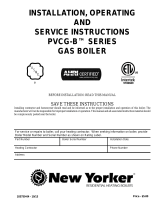
2
CHAPTER 1
CHAPTER 1 - PRE-INSTALLATION REQUIREMENTS
1.2. Removal of an Existing Boiler from a
Common Vent System
Do not install the INSTINCT into a common
vent with any other gas or oil appliances.
This will cause flue gas spillage or appliance
malfunction, resulting in substantial proper-
ty damage, serious injury, or death.
When an existing boiler is removed from a common vent-
ing system, the common venting system is likely to be
too large for proper venting of the remaining appliances.
At the time of removal of an existing boiler, the following
steps shall be followed with each appliance remaining
connected to the common venting system placed in op-
eration, while the other appliances remaining connected
to the common venting system are not in operation.
1. Seal any unused openings in the common venting
system.
2. Visually inspect the venting system for proper size
and horizontal pitch and determine there is no
blockage or restriction, leakage, corrosion and other
deciencies which could cause an unsafe condition.
3. Insofar as is practical close all building doors and win-
dows and all doors between the space in which the ap-
pliances remaining connected to the common venting
system are located and other spaces of the building. Turn
on clothes dryers and any appliance not connected to
the common venting system. Turn on any exhaust fans,
such as range hoods and bathroom exhausts, so they
will operate at maximum speed. Do not operate a sum-
mer exhaust fan. Close replace dampers.
4. Place in operation the appliance being inspected.
Follow the lighting instructions. Adjust thermostat
so appliance will operate continuously.
5. Test for spillage at the draft hood relief opening after 5
minutes of main burner operation. Use the ame of a
match or candle, or smoke from a cigarette, cigar or pipe.
6. After it has been determined that each appliance remain-
ing connected to the common venting system properly
vents when tested as outlined above, return doors, win-
dows, exhaust fans, replace dampers and any other
gas-burning appliance to their previous condition of use.
7. Any improper operation of the common venting system
should be corrected so the installation conforms with
the National Fuel Gas Code, ANSI Z223.1/NFPA 54 and/or
CAN/CSA B149.1, Installation Codes. When resizing any
portion of the common venting system, the common
venting system should be resized to approach the mini-
mum size as determined using the appropriate tables in
Part 11 of the National Fuel Gas Code, ANSI Z223.1/NFPA
54 and/or CAN/CSA B149.1, Installation Codes.
DANGER
1.3. Vent/Combustion Air Piping and Materials
• The INSTINCT appliance is supplied with an
acoustic dampening foam rubber insert lo-
cated in the appliance air inlet adaptor.
DO NOT remove this at installation.
• The installation must conform to the require-
ments of the authority having jurisdiction or,
in the absence of such requirements, to the
National Fuel Gas Code, ANSI Z223.1/ NFPA 54,
and/or Natural Gas and Propane Installation
Code, CAN/CSA B149.1.
The INSTINCT is certied per ANSI Z21.13 as a Category IV
(indoor air) or Direct Vent (sealed combustion) appliance.
A Category IV appliance utilizes uncontaminated indoor
or outdoor air (surrounding the appliance) for combus-
tion. A Direct Vent appliance utilizes uncontaminated out-
door air (piped directly to the appliance) for combustion.
To reduce the potential risks associated with
indoor contaminates (listed on page 11), flam-
mable vapors and tight housing construction
(little or no infiltration air), it is recommended
to pipe uncontaminated combustion air di-
rectly from the outdoors to the appliance. This
practice also promotes higher system efficien-
cy by reducing heated indoor air from being
exhausted from the building and replaced by
cold infiltration air.
The INSTINCT requires a Category IV venting system which
is designed for pressurized venting and condensate.
The vent and combustion air materials (piping,
fittings and cement) must meet the listed re-
quirements in this manual. Failure to comply
with these material requirements can result in
substantial property damage, serious injury, or
death.
NOTICE
BEST PRACTICE
WARNING




















